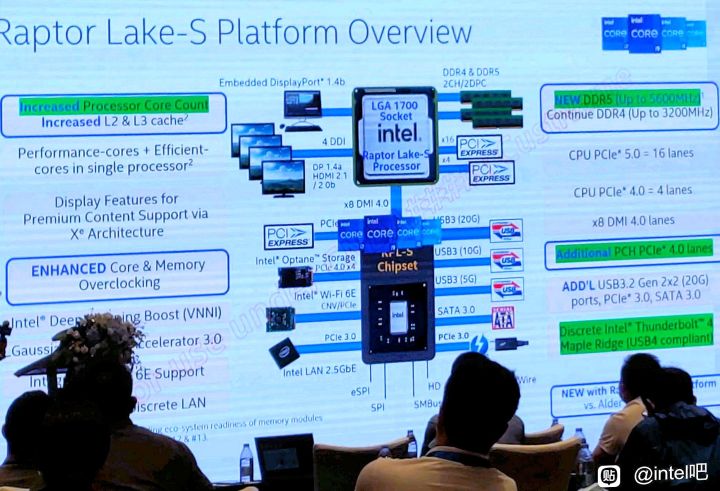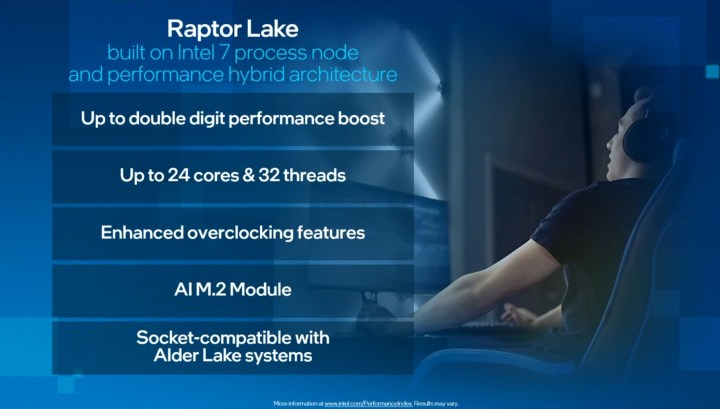New details about Intel’s upcoming 13th-generation Raptor Lake-S processors just emerged, giving us even more insight into the specifications and performance of these CPUs. The information was leaked as part of an Intel NAS Workshop presentation that took place in Shenzhen, China.
At first glance, everything looks great, with higher clock speeds and core counts. However, one key detail seems to have been passed over — there is no mention of PCIe Gen 5.0 support for M.2 modules.

Is it still a leak if the information comes from Intel itself? That’s debatable, but it’s worth noting that Intel didn’t seem to choose to share it with the internet at-large just yet. The leaked slide was posted on the Chinese social media platform Baidu, but it comes from a presentation held by Intel, which gives it a whole new level of gravity compared to the previous leaks we’ve received thus far.
Intel Raptor Lake-S, rumored to release around October of this year, receives a few bits of exciting news from this slide alone. It’s now confirmed to support DDR5-5600 memory, marking a step up from the current-gen Alder Lake with its native DDR5-5200. It also retains support for DDR4-3200 RAM, seeing as it utilizes the same LGA1700 socket as Alder Lake, meaning that current motherboards will support both 12th-gen and 13th-gen Intel processors. Even though you’ll be able to use your current motherboard with Raptor Lake, manufacturers are still expected to release 700-series boards made specifically for 13th-gen processors.
Compatibility aside, Raptor Lake-S marks an upgrade over Alder Lake. The maximum core count will jump to 24 cores and 32 threads, and the new Raptor Cove P-cores will offer better instructions per clock (IPC) than the Golden Cove cores inside Intel Alder Lake. Boost clock speeds will also go way up, with some reports stating that Intel Raptor Lake will offer an up to 30% uplift in performance versus its predecessor and that it might even be capable of hitting 6GHz.
The new platform will also receive support for extra PCIe Gen 4.0 lanes while retaining PCIe Gen 5.0 support. However, there has been no mention of Intel adding new PCIe 5.0 lanes, which implies that Raptor Lake might still be limited to 16 lanes from the CPU. This is the same as Alder Lake, but it’s interesting that this detail has been omitted from the slide.

Assuming Intel doesn’t add any extra PCIe 5.0 lanes, users will have to split the lanes between a discrete graphics card and a new Gen 5.0 M.2 SSD. Although PCIe Gen 5.0 M.2 SSDs are still hard to come by, they will undoubtedly become more widespread during Intel Raptor Lake’s tenure, which might mean that some users will have a difficult choice to make.
Aside from being powerful, the new Intel flagship is going to be power-hungry. The maximum power rating goes up to 260 watts, which, as Wccftech notes, is the highest number seen on the mainstream Intel platform. If you’re planning to pair a Raptor Lake CPU with one of the next-gen best graphics cards from Nvidia, you’ll need a monstrous power supply to ensure that everything is stable.
For the time being, it looks like AMD might beat Intel to the race — next-gen Ryzen 7000 CPUs are rumored to launch in September. However, with the two platforms launching so close together, the electronics market is certainly about to enter an interesting phase.
Editors’ Recommendations




